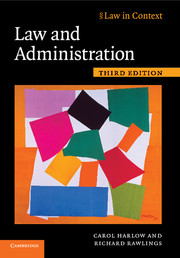Book contents
- Frontmatter
- Contents
- Preface
- Table of Cases
- Table of Statutes
- 1 Red and green light theories
- 2 The changing state
- 3 Transforming judicial review
- 4 Making the law
- 5 Rules and discretion
- 6 Regulation and governance
- 7 Regulatory design and accountability
- 8 Contractual revolution
- 9 Contract, contract, contract
- 10 Into the jungle: Complaints, grievances and disputes
- 11 Tribunals in transition
- 12 The Parliamentary Ombudsman: Firefighter or fire-watcher?
- 13 Inquiries: A costly placebo?
- 14 Continuity and change: Procedural review
- 15 Elite dimension: Court structures and process
- 16 Judicial review and administration: A tangled web
- 17 ‘Golden handshakes’: Liability and compensation
- Index
14 - Continuity and change: Procedural review
Published online by Cambridge University Press: 05 June 2012
- Frontmatter
- Contents
- Preface
- Table of Cases
- Table of Statutes
- 1 Red and green light theories
- 2 The changing state
- 3 Transforming judicial review
- 4 Making the law
- 5 Rules and discretion
- 6 Regulation and governance
- 7 Regulatory design and accountability
- 8 Contractual revolution
- 9 Contract, contract, contract
- 10 Into the jungle: Complaints, grievances and disputes
- 11 Tribunals in transition
- 12 The Parliamentary Ombudsman: Firefighter or fire-watcher?
- 13 Inquiries: A costly placebo?
- 14 Continuity and change: Procedural review
- 15 Elite dimension: Court structures and process
- 16 Judicial review and administration: A tangled web
- 17 ‘Golden handshakes’: Liability and compensation
- Index
Summary
As every student of government should know, the administrative process is shaped not only by executive and legislature but also by courts. This chapter focuses on the judicial contribution in the form of procedural review, classically epitomised in the two Latin tags: audi alteram partem (hear the other side) and nemo iudex in causa sua (no man a judge in his own cause). Suitably hallowed, even hackneyed, the precept that ‘justice must not only be done but be seen to be done’ is the essence of the rule of law.
A first theme of this chapter is judicialisation and we shall find a general tendency to model the administrative process in the courts' own adjudicative image. We may conceive of a sliding scale: the closer to the ‘ideal type’ of formal court procedure, the more ‘judicialised’ the process will be. As emphasised by Lord Diplock's use of the term ‘procedural impropriety’ (see p. 107 above), this trait is inevitably bound up with the role and form of statutory procedural requirements. Our second major theme is the meeting of a quintessential common law tradition with ‘Europe’: both the ECHR and Community law are involved. This important constitutional dimension has a two-way aspect. In Art. 6 especially, the Convention wears the genetic imprint of a deep-rooted Anglo-American concern with natural justice and due process. Again, the ECJ in developing general principles of law has drawn directly on common law requirements of a fair hearing. Conversely, we will see how the Human Rights Act (HRA) has ushered in a new round of judicialisation based on the ECHR. Directed to judicial procedures, but casting a wider shadow, the Art. 6 prescription of an ‘independent and impartial tribunal’ in the determination of ‘civil rights and obligations’ is today a defining aspect of the administrative law landscape.
- Type
- Chapter
- Information
- Law and Administration , pp. 616 - 667Publisher: Cambridge University PressPrint publication year: 2009



